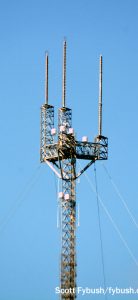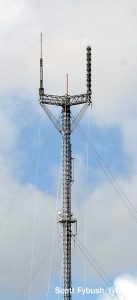NorthEast Radio Watch 10/28/2024: News Changes at GBH
In this week’s issue… GBH shuffles mornings, prepares new show launches - NYSBA inducts Hall of Famers - More news-talk in the Hudson Valley - Remembering Dan Sys
Text and photos by SCOTT FYBUSH
Let’s say, hypothetically, that your first trip to south Florida starts with a flight into Fort Lauderdale-Hollywood Airport. If you’re headed from there into Miami down I-95, and if you’re a tower geek, you may be a bit of a traffic hazard as you approach the Broward/Miami-Dade county line somewhere around Exit 20 and you start noticing a really impressive cluster of tall towers off to the west of the highway. (This being Miami, though, you’re probably far from the least hazardous vehicle on the road no matter how much gawking you’re doing out the window.)
As of 2015, this tower farm consists of seven 1000-foot-class towers, and we’ll look at six of them in detail this week. (The seventh merits an article to itself, and you’ll get that next week.) From north to south, the farm is split by the county line; from east to west, it’s divided by State Route 7/US 441, one of the main highways from Dade to Broward before I-95 was built.
At the northeastern corner of the farm, off the Pembroke Road I-95 exit, we find one of the oldest towers still standing in the farm. This 1041′ candelabra, built in 1969, sits right behind what’s now the studio of Trinity Broadcasting Network’s WHFT (Channel 45/RF 46), which also occupies one of the tines of the candelabra. At one time, this was one of the main FM sites for the market; today, the WHFT tower is home to just two FMs, iHeart’s WBGG-FM (105.9) and SBS’ WXDJ (106.7), as well as to iHeart’s “93.5 the Bull” translator.
Our next stop is just to the southwest, tucked neatly into the middle of a trailer park on Hallandale Beach Boulevard. This was the very first tower site in the farm, back around 1953, when Miami’s original TV station moved north. WTVJ (Channel 4) signed on in 1949 from the Everglades Hotel in downtown Miami, at a time when Miami was a fairly small city and Fort Lauderdale an even smaller community that seemed like it might become its own separate TV market. The TV allocations freeze left Miami as a one-VHF town, Fort Lauderdale began to sprout its own UHF signals that targeted Miami, and suddenly it made sense to plant tall towers right on the county line to serve as much of south Florida as possible.
So channel 4 ended up with this Broward County site for more than three decades before building an even bigger tower to the west, which we’ll see in a bit. After channel 4 moved, a new tower went up here in 2001, a beefy 1019′ candelabra that is (like most of the sites in the farm these days) owned by American Tower.
This candelabra is home to four full-power TV stations: Telemundo’s WSCV (Channel 51/RF 30), UniMas WAMI (Channel 69/RF 47), ion’s WPXM (Channel 35/RF 35) and the Broward County Schools’ WBEC (Channel 63/RF 40).
The big TVs are located in rooms at either end of the barbell-shaped transmitter building, separated by a long room that’s home to a fleet of LPTVs, a long double row of auxiliary transmitters for iHeart’s FMs and one main FM site.
That’s Lincoln Financial Media’s Miramar-licensed 104.3, which was moved into the Miami market from its longtime existence as WEAT-FM up in West Palm Beach. (The main Harris transmitter here is new; what’s now the 104.3 aux is the old WEAT-FM main.) In March, 104.3 was doing sports as WAXY-FM; after Entercom took over from LFM, 104.3 became “Shark” WSFS.
Just across Hallandale Beach Boulevard to the south, a site tucked within McTyre Park off SW 52nd Avenue is currently home to the 1010′ tower of the Miami-Dade School Board’s WLRN-TV (Channel 17/RF 20) and WLRN-FM (91.3), the market’s NPR news outlet. There’s a shorter stubbed-off tower next to WLRN that carries public safety and two-way communications; before it was cut back, this tower was home to two UHF independents licensed to Fort Lauderdale, WDZL (Channel 39, now WSFL-TV) and WKID (Channel 51, now WSCV). And even before that, this site was the studio and transmitter home of the market’s original channel 17, Fort Lauderdale-licensed ABC affiliate WITV, which signed on in 1953 and signed off in 1957 after ABC moved to the new WPST (Channel 10).
From here, we cross the county line a few blocks to the south and head west across 7/441 to the southwesternmost tower in the farm. Today, this 1043-foot tower, capped by a crossbar with two TV antennas, is home to the market’s main public broadcaster, WPBT (Channel 2/RF 18), but this site on NW 199th Street has a fascinating history that long predates the current WPBT. This is the location where George B. Storer planted WGBS-TV (Channel 23), the other of the two UHF signals that tried to compete with WTVJ in the years before the VHF freeze was lifted. WGBS-TV had a primary NBC affiliation and decent coverage from a 540-foot tower at this site, but after it lost its affiliation to newcomer WCKT (Channel 7) in 1956, it quickly folded. Storer sold this site to the new ABC affiliate, WPST (Channel 10), which used it for a few years before building its own new tower just to the north. The channel 23 CP stayed dormant for a decade before being reactivated here as WAJA in 1967; WAJA in turn soon became Spanish-language WLTV and eventually grew into the market-dominant flagship of the Univision network. (Its studios eventually left here for a new home in Doral; we’ll see in a bit where its transmitter went.)
Meanwhile, the market’s second VHF channel signed on in 1955 with educational programming. For 24 years, channel 2 was shared between daytime programs from the Miami school district’s WTHS and evening programs from community educational broadcaster WPBT. WTHS reactivated channel 17 in 1970 as WSEC, a second channel for its educational programming; in 1979, the school board relinquished its half of channel 2 to WPBT and went fulltime on channel 17 under new calls WLRN. WTHS/WPBT originally came to the air from the old WTVJ facilities on the Everglades Hotel, but channel 2 soon moved up here to 199th Street (then known as Honey Hill Road) and here it has remained even as the other users of this site eventually moved elsewhere.
What might remain in these buildings from the old channel 23 and channel 10 days? I’d love to know…
The rest of the tower farm is tightly clustered just north of the WPBT tower, and here’s how it comes together: off NW 207th Street just west of 7/441, a 1042-foot candelabra that belongs to “Miami Tower LLC” is shared by WPLG (Channel 10/RF 10) and WSVN (Channel 7/RF 7), with Lincoln Financial’s WLYF (101.5) as a tenant. This tower, built in 2009 for the DTV transition, replaced an earlier Channel 10 tower at this location, as well as the original channel 7 tower, built in 1956 at a location just to the south across 207th Street.
(Look in the background of the WPBT shot above and you can see the WSVN/WPLG candelabra in the background to the left; at right is the Guy Gannett Tower that we’ll cover in detail next week.)
WLYF has lots of transmitter packed tightly into its building near the tower base, including auxiliary capabilities for sister station WMXJ (102.7) and even an emergency studio just in case something happens to its main studio, located just around the corner from this site. The WLYF signal comes from a panel antenna wrapped around the tower just below the TV stations’ candelabra.




The westernmost tower in the farm is also the newest.
American Tower owns this candelabra, too, as a result of acquisitions that gave it most of the former CBS tower portfolio – but if you trace backwards in history, this 1041′ candelabra that went up in the 1990s originally belonged to WTVJ (Channel 4). Follow along closely here, because this gets confusing: in 1987, NBC bought WTVJ, pulling the NBC affiliation over to channel 4 from WSVN, which went to Fox in 1988. That sent CBS down to WCIX (Channel 6), the former independent that had long struggled with signal problems due to a short-spacing with Orlando’s channel 6.
In 1995, when Westinghouse bought CBS, it sold CBS’ WCAU-TV in Philadelphia to NBC in exchange for NBC-owned stations in Salt Lake City and Denver and NBC’s channel 4 facility here in Miami. The exchange of licenses – but not intellectual property – gave CBS the channel 4 signal (which became WFOR-TV) and this tower site; NBC’s WTVJ moved from channel 4 to channel 6, using the tall tower down in Homestead, 25 miles south of Miami, with an inferior signal over the northern part of the market. (We didn’t get down there on this trip, but we’ll note that Hurricane Andrew toppled that Homestead tower and forced channel 6 to rebuild it at great expense.)
But then came DTV and a move to UHF that ended the short-spacing with Orlando. Now channel 6, too, could operate from the tower farm – and today this candelabra is home to both CBS’ WFOR-TV (Channel 4/RF 22) and NBC’s WTVJ (Channel 6/RF 31). This tower also hosts antennas for Univision’s WLTV (Channel 23/RF 23), CBS’ MyNetwork affiliate WBFS (Channel 33/RF 32), Tribune’s CW outlet WSFL-TV (Channel 39/RF 19), and several LPTVs, too. There’s a big FM master antenna system that currently has just two occupants: CBS Radio’s WKIS (99.9 Boca Raton) has its main site here and sister station WPOW-FM (96.5) has an aux.
Where’s the rest of the FM? We’ll see that amazing site (the former “Guy Gannett Tower”) in our next installment…
Thanks to the Miami engineering community, and especially to Lincoln Financial Media’s Gary Blau and iHeart’s Jim Leifer, for the tours!
 We don’t have a cover yet (stay tuned for that reveal soon!), but we’re hard at work on an achievement we never thought we’d reach – the landmark 24th edition of the world-famous Tower Site Calendar.
We don’t have a cover yet (stay tuned for that reveal soon!), but we’re hard at work on an achievement we never thought we’d reach – the landmark 24th edition of the world-famous Tower Site Calendar.
It’s not just a useful wall calendar. It’s also a tribute to more than a century of radio history.
And the proceeds from the calendar help sustain the reporting that we do on the broadcast industry here at Fybush Media, so your purchases matter a lot to us here. For just a few weeks, you can pre-order your 2025 calendar at a discount price, so it’s a good deal for you, too, as postage and printing costs keep going up. Visit the Fybush Media Store and place your pre-order now for the next calendar, get a great discount on previous calendars, and check out our selection of books and videos, too!
Next week: More Miami, 2015
In this week’s issue… GBH shuffles mornings, prepares new show launches - NYSBA inducts Hall of Famers - More news-talk in the Hudson Valley - Remembering Dan Sys
In this week’s issue… Beasley cuts claim veteran jock - FCC releases LPFM decisions - AM towers coming down - New voices at Indie 88
In this week’s issue… Remembering J.J. Jeffrey, Canada's Bullard - Cumulus surrenders WFAS license - 7 Mountains shuffles Hornell, Mansfield signals - TV director's death cancels newscast
In this week’s issue… FCC regulatory questions vex broadcasters - Promotion for Ford - Levine back on the scene - Curry retires from Lehigh Valley's Hawk